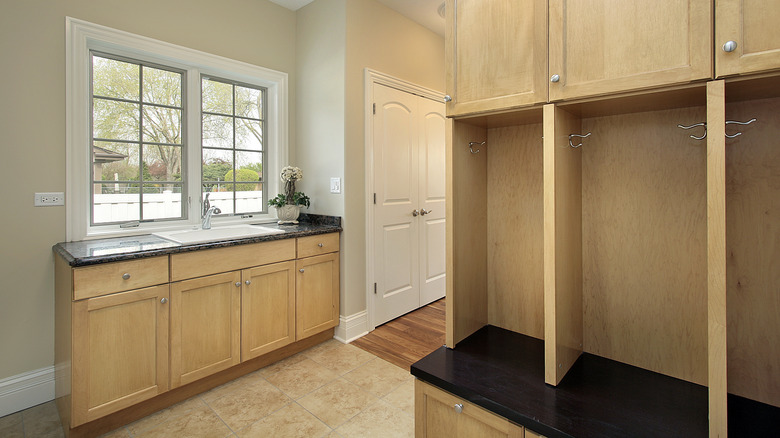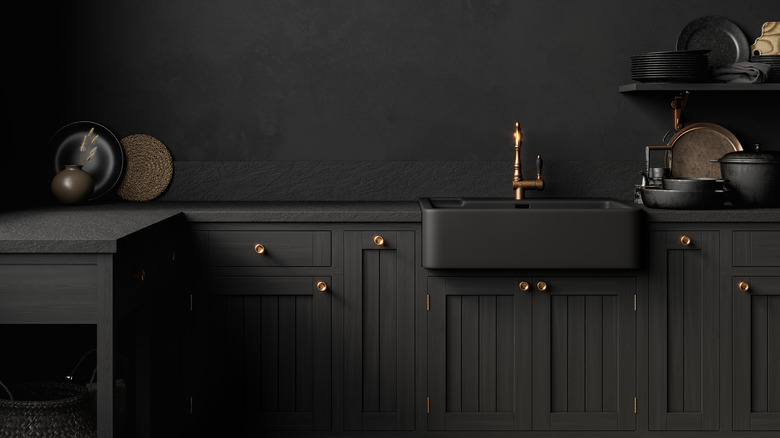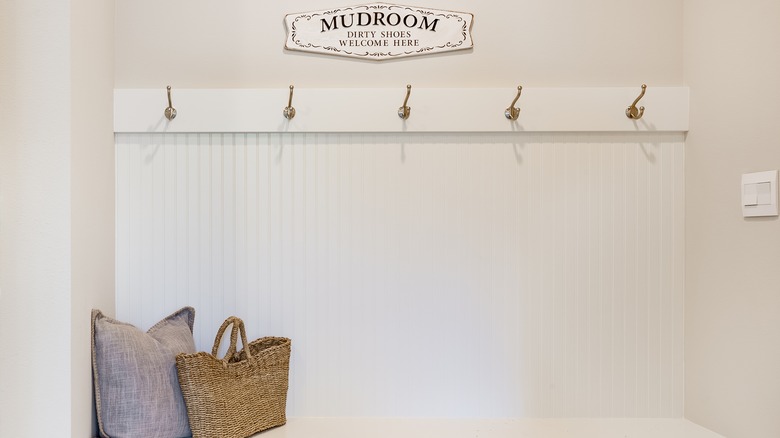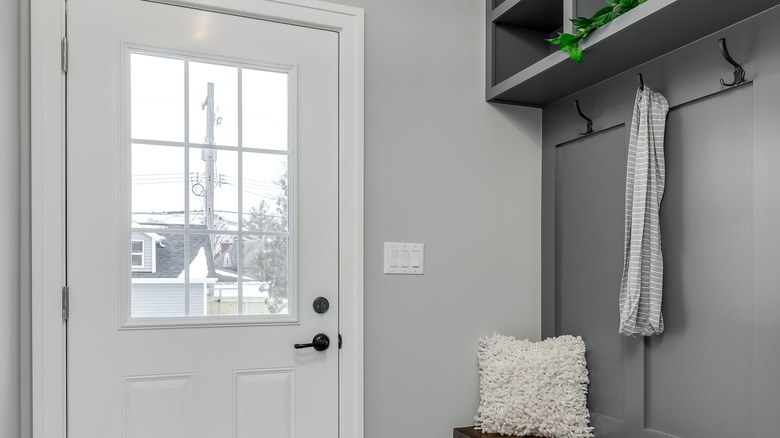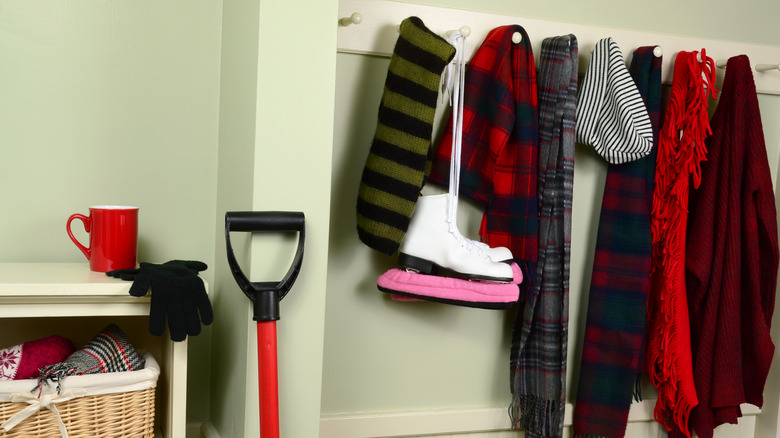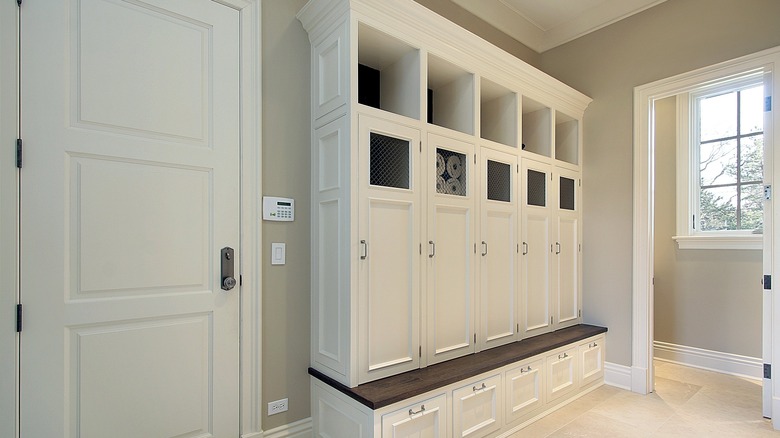Colors You Should Avoid When Painting Your Home's Mudroom
Traditionally, single-family houses have a formal, front-facing entry called a vestibule, foyer, or center hall. But just as necessary for easy, organized family living is the back entrance, the drop zone where everything from sports equipment to backpacks can be stowed conveniently and accessibly. In a lot of houses, the mudroom is the last place the family leaves to get to school, work or run errands, and it's the first place they enter from the garage or back door every day. So it's important that the mudroom is not only organized but pleasant and welcoming.
Even homes without an entire room dedicated to getting family in and out can have a dedicated landing space, and we have ideas for a mudroom or mudroom area for your house. Whether your drop zone is large with built-in cubbies and lockers or just a few hooks and a shelf, clean lines are helpful, and order is imperative. In this room, color has an enormous impact, so know there are a handful of colors that you should completely disqualify as contenders for your mudroom. Don't use colors that are too dark or too light, and avoid colors that are too bright or have a high emotional impact. Also, this area will have lots of traffic every day, so use a color that will show the least amount of wear and tear.
Dark brown and black
Even the name, mudroom, is reminiscent of an era when people entered a home somewhat worse for wear after traveling in streets filled with horses and carriages. A lot of dirt and worse would stick to shoes and hems. The mudroom was where people shed and stored cloaks and boots in an attempt to keep dirt out of the rest of the house. In an era before vacuum cleaners, a darker-toned room often hid much of the dust and dirt. Today we have it easier, mud-wise, so there's no reason to have mud-colored walls.
With mudrooms, space is often at a premium, and as a transitional space, natural light usually is in short supply. While a black accent wall may be stunning in an all-white formal room, a black mudroom would look creepy, like a cave. Similarly, a velvety dark brown can be appealing in a dining room or den, but without the natural glow from a window or a skylight, a small, dark brown room will just feel cramped and depressing – hardly the feeling you want coming and going from your home daily. Additionally, black and brown walls show dirt just as much as light colors. This is especially true if you're in a cold climate with road salt being tracked in or anywhere pollen can float in and mar the walls.
Shades of white
The challenge with white isn't the color; it's the tone you pick for the mudroom. Given that there are hundreds of shades of white, choosing the best one can be challenging. One of the reasons there are so many whites is because there are so many colors in general. Dozens of whites have an undertone, creating a new shade. Think mint green, then make it as pale as possible until you have white with a mint undertone. With the variety of undertones, white sometimes looks warm and inviting, like vanilla or the palest pink or coral. But it can also look stark, even bleak. The colors we use in our environment, even white, affect our mood.
One white tone to avoid is that completely blank white or chalk white. There's no reason to use a color like this with no depth or charm when there are so many other attractive whites to choose from. More practically, white, no matter what tone it has, will show scuffs and stains regularly. Even letting dogs in and out can create a spot along the lowest part of the door jamb or wall. A durable paint can handle multiple scrubbings, and repainting is always a solution. But why set yourself up for extra work? Skip the whitest white and apply something more family-friendly.
Undertones matter
In a mudroom, additional whites to keep away from are warmer shades with a brown or yellow undertone. Unfortunately, these two spectrums look dingy in small spaces, as if the walls aren't clean. Often people are trying to get a lighter color for their walls or trim using the wood floor or shelves as the base color and choose to go much lighter. Unfortunately, that brown or yellow undertone looks like a dull, dirty wall rather than the pristine, organized space you want.
Even if you opt for colors that flatter a small room, such as gray or beige, pay attention to the undertones. If your color scheme is dark blue with wood trim and you use a shade of gray with a lot of red in it, the gray will look purple or lavender compared to the rest of the room. A beige with too much yellow in it will drag dark colors down and mute lighter colors as well, giving the space a stained, muddied look. Similar to black and brown, a medium to dark beige will show light-colored dust and scrapes. Multiple hits from backpacks or sports equipment rubbing against the surface will create pale spots that are repaired by repainting.
Use color wisely
Bright, concentrated color on the wall is one of the quickest and easiest ways to express your personality. But use color judiciously inside the house. While a bright red scarf may make you feel happy, a room full of red walls will make you feel anxious. Bold colors like red, deep orange, and even bright yellow are the most visible to the eye. Their appearance in nature is often associated with things that are dangerous — poisonous berries, for example — and our bodies have a natural, innate reaction to them.
For interiors, a better way to express your love of red is with accents and accessories rather than the walls. In the mudroom, usually a tight little space, bold colors like red are magnified. If red pushes that feeling of anxiety in a large room, imagine how its intensity will feel in a mudroom. For a room you will probably enter at least twice a day, work with a more muted shade of these colors, or avoid hot colors altogether, opting for cool hues such as greens and blues instead.
Finally, the finish
Once you've picked out the perfect color, the second question you'll be asked at the paint store is which finish you want to use. The paint's finish in the high-traffic area that defines a mudroom is as important as the shade you use. There are five finishes. From the dullest to the shiniest, in terms of reflecting light, they are flat, eggshell, satin, semi-gloss, and high gloss. Each has its pros and cons.
The mudroom will see more than its share of scrapes and scuffs along the walls, so paint that's easy to clean is an absolute must. A satin finish might do well here, but the most popular finish for other high-traffic areas, such as kitchens and bathrooms, is semi-gloss. This finish is easiest to clean and durable enough to withstand frequent cleaning. Its polished sheen will reflect light in the mudroom, giving the room a soft glow that helps color pop. One last consideration for color and finish for your mudroom is that the entry is often visible from the kitchen or eat-in area. Think about how you would like the mudroom to complement or contrast with the kitchen or room next to it to help make the space an extension of your daily living area.
